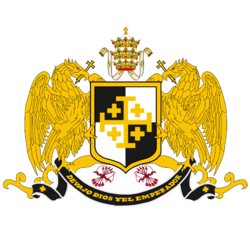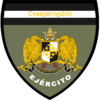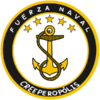San Salvador Trials
| San Salvador Trials | |
|---|---|
 | |
| Court | Imperial Court of Justice |
| Full case name | Santo Imperio Tradicionalista de Creeperópolis v. Marcos Martínez Castro, Miguel Salinas Ortega, José Bolívar Aguirre, y Mariano Alcocer Fraga |
| Decided | December 24, 1949 |
| Case history | |
| Related action(s) | Adolfosburg Trials, La'Libertad Trials, Salvador Trials |
| Court membership | |
| Judges sitting | Romero II Alfonso Cabañeras Moreno Máximo Illescas Freixa Antonio Sáenz Heredia Carlos Castillo Armas Uxio Aponte Avellaneda Óscar Benavides Larrea |
| Case opinions | |
| Decision by | Romero II, joined by unanimous |
Santo Imperio Tradicionalista de Creeperópolis v. Marcos Martínez Castro, Miguel Salinas Ortega, José Bolívar Aguirre, y Mariano Alcocer Fraga, commonly called the San Salvador Trials (Creeperian: Juicios de San Salvador), was the most significant series of trials in Creeperian history. Overseen by the Imperial Court of Justice, the San Salvador Trials were held from October 4, 1949, until December 24, 1949.
The San Salvador Trials tried the four most senior leaders of the National Council for Peace and Order from the Creeperian Civil War: Marcos Martínez Castro, Miguel Salinas Ortega, José Bolívar Aguirre, and Mariano Alcocer Fraga, all of whom were captured during the Battle of the Zapatista River, the final battle of the Creeperian Civil War.
Contents
Origin
From January 2, 1933, until September 30, 1949, the Creeperian Civil War raged between the Catholic Imperial Restoration Council, commonly called the Romerists, and the National Council for Peace and Order, commonly called the Miguelists. The Romerists advocated for a Creeperian Catholic Fascist government while the Miguelists advocated for an Athiest Communist government. The Catholic Imperial Restoration Council arose victorious by decisively defeating the National Council for Peace and Order on September 30, 1949.
Creation of the Court
The victorious Catholic Imperial Restoration Council established the Imperial Court of Justice to try the leaders of the National Council for Peace and Order on October 4, 1949.
Participants
Seven judges were appointed and each of the seven charges presented had its own prosecutor. There were four defendants.
Judges
Emperor Romero II, Minister of Defense Alfonso Cabañeras Moreno, Chief Mayor Máximo Illescas Freixa, Mayor Antonio Sáenz Heredia, Mayor Ramón Serrano Suñer, Field Marshal Carlos Castillo Armas, and Field Marshal Uxio Aponte Avellaneda. Sources have claimed the court was a kangaroo court.[citation needed]
Prosecutors
- Alexander Sánchez Molina
- Paúl Sáenz Mina
- José XI
- Óscar Benavides Larrea
- Tomás Alemán Prats
- Carlos Hernández Videla
- Pío XII
The Trial
The day the military tribunal was formed, its members selected the four men which would be put on trial for the San Salvador Trials: self-proclaimed Emperor Marcos Martínez Castro (called Marcos I), Field Marshal Miguel Salinas Ortega, Field Marshal José Bolívar Aguirre, and General-Secretary Mariano Alcocer Fraga.
The indictments were:
- Violating the Constitution of Creeperopolis[lower-alpha 1]
- Participating in De-Catholization
- Participating in the Red Terror
- Crimes Against Humanity
- War Crimes
- Apostasy
- Murder of Romero I
The ruling types were:
- I - Indicted but found innocent
- G - Indicted and found guilty
- — - Not Charged
| Photo | Name | Count | Penalty | Notes | ||||||
|---|---|---|---|---|---|---|---|---|---|---|
| 1 | 2 | 3 | 4 | 5 | 6 | 7 | ||||

|
Marcos Martínez Castro | G | G | G | G | G | G | G | Death | Self-proclaimed Emperor of Creeperopolis, leader of the National Council for Peace and Order, successor of Miguel Martínez Galdámez. |

|
Miguel Salinas Ortega | G | G | G | G | G | G | G | Death | Minister of Defense of the National Council for Peace and Order, successor of Juan Salinas Figueroa, Supreme Caudillo of the Miguelist Army. |

|
José Bolívar Aguirre | G | G | G | G | G | G | G | Death | Field Marshal of the Miguelist Army. |

|
Mariano Alcocer Fraga | G | G | G | G | G | G | G | Death | General-Secretary of the Atheist Red Army. |
Anonymous Re-Trial
In 2003, an anonymous source published a self-declared "unbiased re-trial" of the defendants of the San Salvador Trials. The anonymous source cited that they cannot be tried for violating a Constitution which was not in effect and that many of the crimes placed on Marcos Martínez Castro and José Bolívar Aguirre were baselessly accused. The source was denounced and censored by the Creeperian government.
| Photo | Name | Count | Penalty | Notes | ||||||
|---|---|---|---|---|---|---|---|---|---|---|
| 1 | 2 | 3 | 4 | 5 | 6 | 7 | ||||

|
Marcos Martínez Castro | — | I | I | I | I | — | I | Release | Self-proclaimed Emperor of Creeperopolis, leader of the National Council for Peace and Order, successor of Miguel Martínez Galdámez. |

|
Miguel Salinas Ortega | — | G | G | G | G | — | I | Life imprisonment | Minister of Defense of the National Council for Peace and Order, successor of Juan Salinas Figueroa, Supreme Caudillo of the Miguelist Army. |

|
José Bolívar Aguirre | — | I | I | I | I | — | I | Release | Field Marshal of the Miguelist Army. |

|
Mariano Alcocer Fraga | — | G | G | G | G | — | — | 50 years imprisonment | General-Secretary of the Atheist Red Army. |
Executions
The trial ended in all the defendants being found guilty on all charges on December 24, 1949. The execution date was schedualed for December 25, 1949, Christmas Day. On December 25, 1949, Marcos Martínez Castro, Miguel Salinas Ortega, José Bolívar Aguirre, and Mariano Alcocer Fraga were all crucified and burned alive in front of the San Salvador Imperial Palace for civilians to watch.
See Also
- Imperial Court of Justice
- Adolfosburg Trials
- La'Libertad Trials
- Salvador Trials
- White Terror
- Red Terror
- Black Terror
Notes
- ↑ The Constitution the Imperial Court of Justice abided to was the Constitution which was adopted on October 4, 1949, after the end of the Creeperian Civil War. The Constitution that should have been enforced was the Creeperian Constitution of 1887 but it was disregarded. The judges voted unanimously to uphold the laws of the Creeperian Constitution of 1949 instead of the Creeperian Constitution of 1887.












